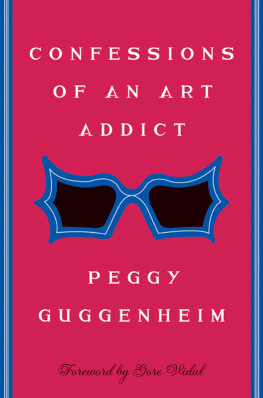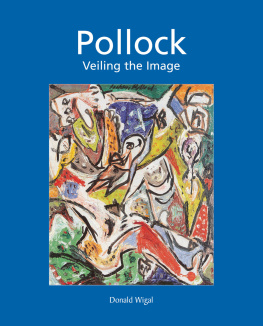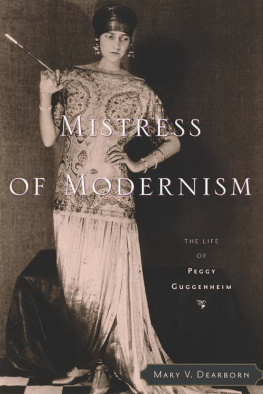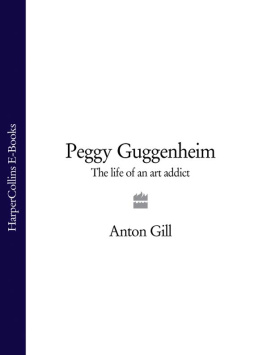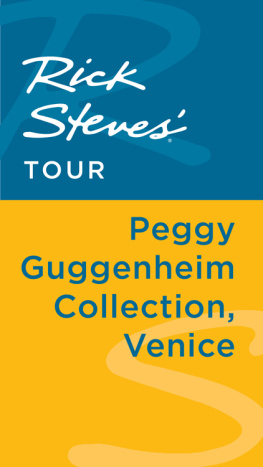PEGGY GUGGENHEIM

Peggy Guggenheim
The Shock of the Modern
FRANCINE PROSE

Frontispiece: Solomon R. Guggenheim Foundation. Photo Archivio
CameraphotoEpoche. Gift, Cassa di Risparmio di Venezia, 2005.
Solomon R. Guggenheim Foundation. Photo Archive.
Copyright 2015 by Francine Prose.
All rights reserved.
This book may not be reproduced, in whole or in part, including illustrations, in any form (beyond that copying permitted by Sections 107 and 108 of the U.S. Copyright Law and except by reviewers for the public press), without written permission from the publishers.
Yale University Press books may be purchased in quantity for educational, business, or promotional use. For information, please e-mail (U.K. office).
Set in Janson Oldstyle type by Integrated Publishing Solutions.
Printed in the United States of America.
Library of Congress Control Number: 2015932202
ISBN 978-0-300-20348-6 (cloth : alk. paper)
A catalogue record for this book is available from the British Library.
This paper meets the requirements of ANSI/NISO Z39.48-1992
(Permanence of Paper).
10 9 8 7 6 5 4 3 2 1
In writing about Peggy its important to listen to ones own instinct. Dont listen to critics. What do they know? What one should say about Peggy is, simply, that she did it. That no matter what her motivations were, she did it.
Lee Krasner
_________________
I am not an art collector. I am a museum.
Peggy Guggenheim
CONTENTS
Illustrations follow
PEGGY GUGGENHEIM
The Angel of the City
I begin to see Peggy Guggenheim as the last of Henry Jamess transatlantic heroines, Daisy Miller with rather more balls.
Gore Vidal
THE PEGGY Guggenheim Collection is visible from the water, from the private boats, and from the vaporetto, the public ferry that crisscrosses the Grand Canal on its serpentine course through Venice. The museum is located in the Palazzo Venier dei Leoni, a palace that was begun in the eighteenth century and left unfinished, its construction interrupted some decades before the Napoleonic Wars. The white building, with its stone faade, is arresting, partly because it has only one story and is so unlike the tall, elaborate Gothic, Renaissance, and Baroque palazzi that line the Canal, and partly because something about its spare, slightly severe elegance makes it a bit difficult to place in time. Is it eighteenth century, neoclassical, or modern? An ancient Roman temple with a hint of the 1950s ranch house?
For thirty years it was where Peggy Guggenheim lived and where she installed one of the worlds greatest collections of modern artand it is where that art has remained since her death in 1979. Among the artists represented in the collection that she began to assemble long before the significance and value of their work was widely or fully recognized are Picasso, Pollock, Brancusi, Arp, Braque, Calder, de Kooning, Rothko, Duchamp, Ernst, Giacometti, Kandinsky, Klee, Lger, Magritte, Mir, Mondrian, Man Ray, Henry Moore, and Francis Bacon.
It was Peggys decision to place Marino Marinis 1948 bronze The Angel of the City (LAngelo della Citt) at the entrance to her home, front and center on the landing facing the Grand Canal and nearly impossible not to notice if one is passing by boat. The bronze statue depicts a heavily simplified and abstracted horse and rider, reminiscent of Etruscan sculpture. The horses neck and head are more or less parallel to the ground. The riders body rises from the horse, at a right angle. His arms are outstretched and flung open wide, his head tipped back, as if in ecstasy. His body is arched, his phallus erect. The statues most striking visual elements are: horse, rider, penisspecifically, a penis pointed at the traffic, the boats and passengers traveling between the museum, and, on the other side of the Grand Canal, the massive Palazzo Corner, which serves as the headquarters of the prefect of Venice. In her memoir, Peggy claims that Marini fashioned the statue so that the phallus was removable and that she detached it when she knew that nuns might be passing by.
There were many works of sculpture that Peggy could have chosen for the landing, and it says something about her natureher ironic, playful, lifelong desire to shockthat she selected this particular piece of modern art with which to amuse or confront the officials and citizens of Venice. Peggys mentor and adviser, the art critic and historian Sir Herbert Read, described the statues placement as a challenge to the prefect.
Peggy claimed that the best view of it was in profile, from her living room, where she liked to sit and observe visitors reacting to Marinis work. What also makes the gesture so characteristic of Peggy are the contradictions and the ambivalence it expresses, the particular mixture of affection and provocation: Venice was, after all, a city that she deeply loved.
Out of This Century
IN 1946 Peggy Guggenheim published Out of This Century, a wry and revealing account of her life so far. She was forty-eight years old. In New York, her avant-garde museum-gallery, Art of This Century, was a critical and popular success. Opened in October 1942, the innovatively designed exhibition space on West 57th Street had become a gathering place for the most important artists then working in New York, a showcase for exiled European migrs and talented young American painters.
One of Peggys assistants, Marius Bewley, noted who came to the gallery, how often, and for how long: Breton (around a great deal); Tanguy (often); Fernand Lger, Ossip Zadkine, and Marc Chagall; Matta, Pavel Tchelitchew (was there a lot); Duchamp (frequently); Man Ray (once or twice); Barr (frequently); Kiesler, Alexander Calder (all the time); James Johnson Sweeney (would stay all day); Motherwell, Jean-Paul Sartre Pollock, Gypsy Rose Lee, David Hare, Clyfford Still, Herbert Read (spent a lot of time); Mary McCarthy (occasionally); and so on.
Art of This Century, itself an example of what would later be called installation art, remained a cultural force in New York (and the wider world) from 1942 until 1947. At the gallery, viewers could study masterpieces such as Brancusis Bird in Space, works that might possibly have survived without Peggys intervention, but which she had rescuedalong with many examples of what the Nazis termed degenerate artfrom Europe on the brink of World War II. At Peggys gallery, one could contemplate the work of the Surrealists in a setting that was livelier and more exciting than any existing museum or exhibition space.
Peggy was neither the first nor the only person to introduce Surrealism to the United States; there had already been shows at the Museum of Modern Art and at private galleries. But she was very good at making sure that it was talked about by critics and seen by younger artists. She encouraged and showed the work of a new generation of Americans, and it is partly thanks to Peggy that American artists shook off the influence of Europe. One can only speculate about how different the history of modern art would have been had Peggy not commissioned Jackson Pollock to paint a mural for the hallway of her East Side apartmenta work that helped change the ways in which Pollock and his peers thought about painting.
By 1944, when Peggys friend the art critic Clement Greenberg began urging her to write her memoir, the gallery no longer required her constant presence, as it had at the start. Her marriage to Max Ernst had ended the previous year, when hed left her for the painter Dorothea Tanning. Peggy was living in a brownstone on East 61st Street with a wealthy British art collector, Kenneth Macpherson, a homosexual with whom she was having a complicated and disappointing love affair. Her penchant for brief, casual erotic entanglements had taken on a frenetic edge, and she had reason to be concerned about her daughter Pegeen, whose unhappiness and instability were becoming increasingly obvious and who had gotten into trouble in Mexico, from which she had had to be rescued by her father. Peggy was also disturbed and depressed by the war, and by the news from Europe, where she had spent much of her adult life, and which, as an American Jew in Nazi-occupied France, she had been forced to leave.
Next page




